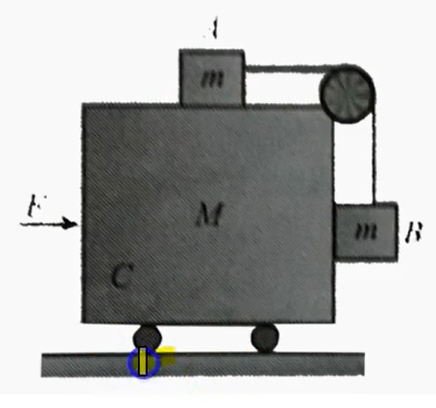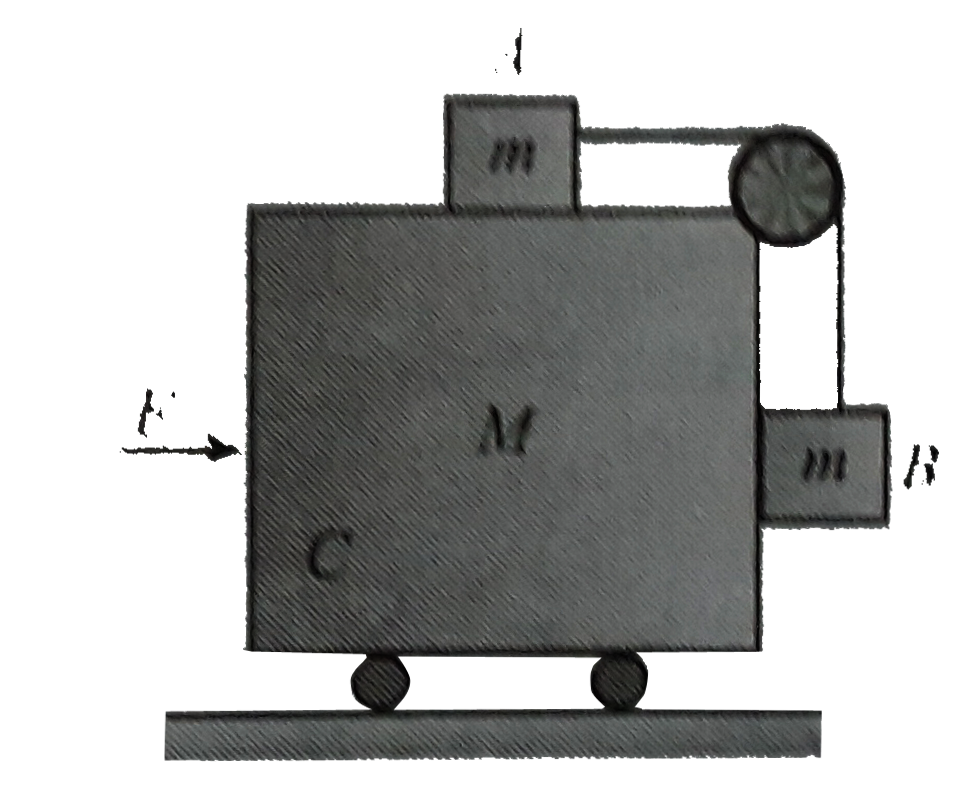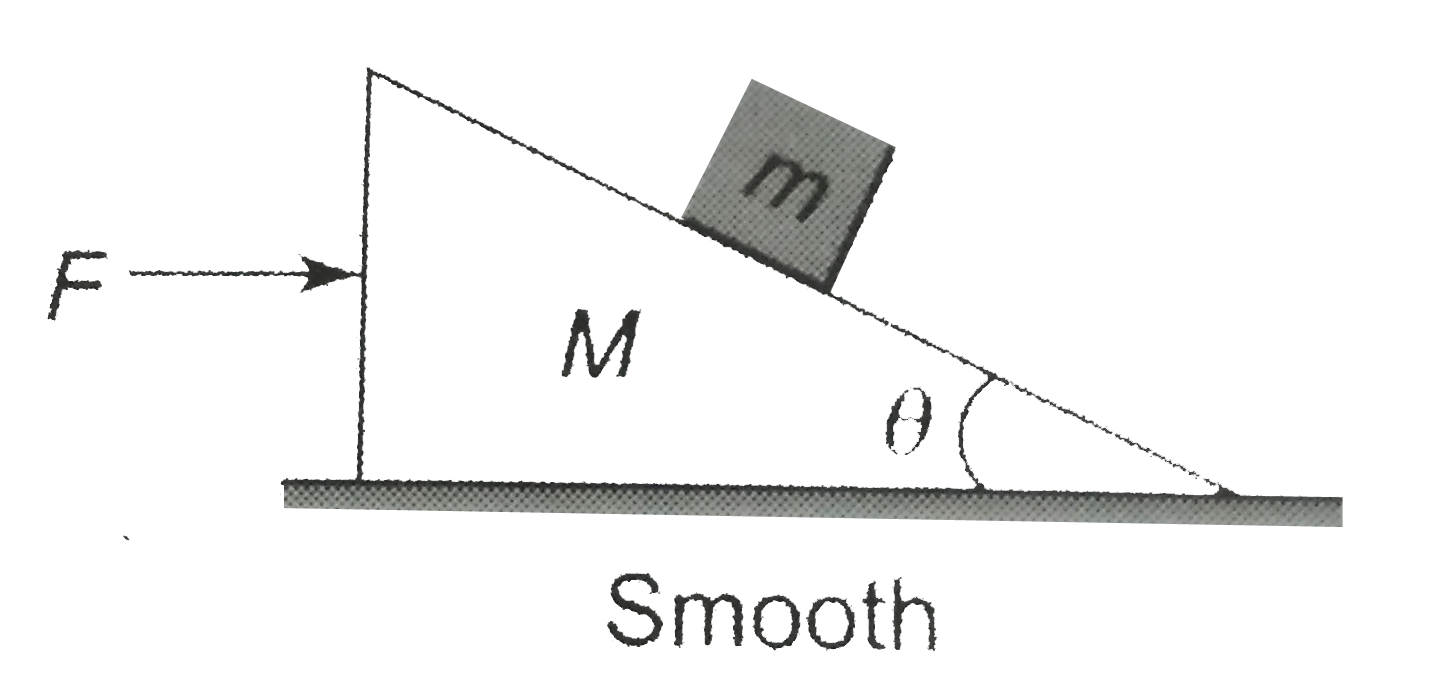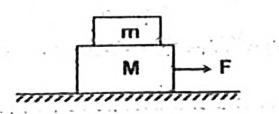Consider the situation shown in figure. The horizontal surface below the bigger block is smooth. The coefficient of frictioin bewen the blocks is μ. Find the minimum and the maximum force F that can be applied in order to keepthe smaller block at respect to the bigger block.

If no force is applied, the block A will slip on C towards right and the block B will move downward. Suppose the minimum force needed to prevent sliping is F. Taking A+B+C as the system, the obly exterN/Al horizontal force on the system is F. Hence the acceleratioinof the system is
a=FM+2m..........i
Now take the block a as the system. The forces on A are.
 ,
,

i. tension t by the string towards right,
ii. friction fi by the block C towards left,
iii. weight mg downward and
normal force N upward
For veticla equilibrium N=mg
As the minimum force neede dto prevent slipping is appied, the fricton is limiting. Thus,
f=mu N=mu mg<br>Astheblockmoves→wardsrightwithanae≤rationa<br>T-f=ma<br>orT-mu mg=ma.........ii<br>NowtaketheblockBasthesystem.Theforcesare,<br>i.TensionTupward<br>ii.weightmgdownward<br>iii.∥a∥lforceN→wardsrightand<br>ictionfupward<br>Astheblockmoves→wardsrightwithanae≤rationa,<br>N'=ma<br>Astheictionislimit∈gf'=mu N'=mu ma<br>Forverticalequilibrium<br>T+f'=mg<br>orT+mu ma =mg..........iii<br>ElimiNAt∈gTomii.andiii<br>a_(min)=(1-mu)/(1+mu) g.<br>Whenalar≥forceisapπedtheblockAslipsonC→wards≤ftandtheblockBslipsonC∈theupwarddirect∈.TheictiononAis→wardsrightandtˆonBisdownwards.Solv∈gasabove,theae≤ration∈thiscaseis<br>a_(max)=(1+mu)/(1-mu)g<br>Thus,aliesbetween(1-mu)/(1+mu)g and (1+mu)/(1-mu)g<br>omtheforceFshod––bebetween<br> (1-mu)/(1+mu)(M+2m) g and (1+mu)/(1-mu)(M+2m)g.
Topper's Solved these Questions
- FRICTIONBOOK - HC VERMACHAPTER - FRICTIONEXERCISE - Short Answer
11 Videos
- FRICTIONBOOK - HC VERMACHAPTER - FRICTIONEXERCISE - Objective 1
10 Videos
- FRICTIONBOOK - HC VERMACHAPTER - FRICTIONEXERCISE - Exercises
31 Videos
- FLUID MECHANICSBOOK - HC VERMACHAPTER - FLUID MECHANICSEXERCISE - Exercises
35 Videos
- GRAVITATIONBOOK - HC VERMACHAPTER - GRAVITATIONEXERCISE - Exercises
39 Videos
Similar Questions
Consider the situation shown in Fig. The hirizontal surface below the bigger block is smooth the coefficient of friction between the block is μ find the minimum and the maximum force F that can be applied in order to keep the smaller blocks at rest with respoct to the bigger block

View SolutionConsider the situation shwon in Fig. 7.49 . The horizontal surface below the bigger block is smooth . The coefficient of friction between the blocks is μ . Find the minimum and maximum accelerations with which the system should move in order to keep the smaller blocks at rest with respect to the bigger block .

View SolutionConsider the situation shown in the figure . The coefficient of friction between the blocks is μ. Find the minimum and the maximum force F that can be applied so that two blocks move together.

View Solution
Find out the range of force for which smaller block is at rest with respect to bigger block.
View SolutionConsider the situation as shown in the figgure. The coefficent of friction between the blocks is μ. Find the acceleration of each block.

View SolutionA block of mass m is placed on another block of mass M lying on a smooth horizontal surface as shown in the figure. The co-efficient of friction between the blocks is μ. Find the maximum horizontal force F (in Newton) that can be applied to the block M so that the blocks together with same acceleration? (M=3kg,m=2kg,μ=0.1,g=10m/s2)

View SolutionTwo blocks of Masses M and 2M are connected by a spring of stiffness k .The coefficient of friction between the blocks and the surface is mu Find the minimum constant force F to be applied to 2m in order to slide the mass M .
View SolutionIn the adjoining figure, the coefficient of friction between wedge ( of mass M) and block ( of mass m) is μ.
Find the minimum horizontal force F rquired to keep the block stationary with respect to wedge

View SolutionIn the adjoining figure, the coefficient of friction between wedge (of mass M) and block (of mass m) is μ.
Find the minimum horizontal force F required to keep the block stationary with respect to wedge.

View SolutionThe coefficient of static friction between the two blocks shown in figure is μ and the table is smooth. What maximum horizontal forced F can be applied to he block of mass M so that the block move together?

View Solution
